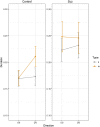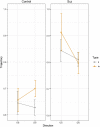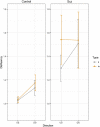Examining Motor Anticipation in Handwriting as an Indicator of Motor Dysfunction in Schizophrenia
- PMID: 35432092
- PMCID: PMC9012163
- DOI: 10.3389/fpsyg.2022.807935
Examining Motor Anticipation in Handwriting as an Indicator of Motor Dysfunction in Schizophrenia
Abstract
Dysfunction in motor skills can be linked to alterations in motor processing, such as the anticipation of forthcoming graphomotor sequences. We expected that the difficulties in motor processing in schizophrenia would be reflected in a decrease of motor anticipation. In handwriting, motor anticipation concerns the ability to write a letter while processing information on how to produce the following letters. It is essential for fast and smooth handwriting, that is, for the automation of graphomotor gestures. In this study, we examined motor anticipation by comparing the kinematic characteristics of the first l in the bigrams ll and ln written on a digitiser. Previous studies indicated that the downstroke duration of the first l is modulated by the anticipation of the local constraints of the following letter. Twenty-four adult individuals with diagnosis of schizophrenia and 24 healthy adults participated in the study. The classic measures of duration (sec), trajectory (cm), and dysfluency (velocity peaks) were used for the kinematic analysis of the upstroke (US) and downstroke (DS). In the control group, the duration of the downstroke of the l was longer in ln than ll (US: ln = ll; DS: ln > ll) whereas no differences were found for the group with schizophrenia. Likewise, the control group showed a longer DS trajectory for the l of ln than ll in downstrokes, while the group of patients failed to show this effect. These results suggest that the motor alterations in patients with schizophrenia could also affect their ability for motor anticipation.
Keywords: handwriting; kinematical measurement; motor alterations; motor anticipation; schizophrenia.
Copyright © 2022 Crespo Cobo, Kandel, Soriano and Iglesias-Parro.
Conflict of interest statement
The authors declare that the research was conducted in the absence of any commercial or financial relationships that could be construed as a potential conflict of interest.
Figures





Similar articles
-
Detecting anticipatory events in handwriting movements.Perception. 2000;29(8):953-64. doi: 10.1068/p2864. Perception. 2000. PMID: 11145087
-
Visual perception of motor anticipation in cursive handwriting: influence of spatial and movement information on the prediction of forthcoming letters.Perception. 1997;26(7):905-12. doi: 10.1068/p260905. Perception. 1997. PMID: 9509142
-
The elaboration of motor programs for the automation of letter production.Acta Psychol (Amst). 2018 Jan;182:200-211. doi: 10.1016/j.actpsy.2017.12.001. Epub 2017 Dec 9. Acta Psychol (Amst). 2018. PMID: 29229183
-
Interaction of attention and graphomotor functions in children with attention deficit hyperactivity disorder.J Neural Transm Suppl. 2007;(72):249-59. doi: 10.1007/978-3-211-73574-9_31. J Neural Transm Suppl. 2007. PMID: 17982901 Review.
-
[Graphomotor functions in children with attention deficit hyperactivity disorder (ADHD)].Psychiatr Pol. 2009 Mar-Apr;43(2):183-92. Psychiatr Pol. 2009. PMID: 19697788 Review. Polish.
References
-
- Bates D., Mächler M., Bolker B. M., Walker S. C. (2015). Fitting linear mixed-effects models using lme4. J. Stat. Softw. 67, 1–48. doi: 10.18637/jss.v067.i01 - DOI

